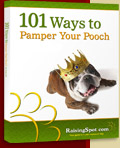Dental Care and Your Dog
Did you know dogs get cavities? In fact, dogs get all the same problems with their mouths we do: cavities, gum disease, abscesses, and bad breath. Further, in addition to causing pain in their own right, mouth problems can lead to infections, heart problems, and death.
How can you tell if your dog has a problem? Look inside the dog’s mouth. Are the gums red and swollen? Is there yellow or black gunk on the teeth, especially at the gum line? Does the dog’s breath knock you over? You need to have a veterinarian examine your dog and see if his teeth need cleaning.
If your dog stops eating, or only chews on one side of his mouth, he may have a bad tooth. This, too, requires a veterinarian to help. Dog’s cavities are not usually filled, but the tooth can be taken out to stop the pain.
Preventing tooth problems in dogs is similar to preventing tooth problems in humans. There is special toothpaste formulated for dogs that you can use to brush your dog’s teeth each day. Never use human toothpaste as it will upset the dog’s stomach. Doggy toothpaste comes in flavors such as beef and chicken and most dogs learn to enjoy having their teeth brushed. Your veterinarian can show you how to teach your dog to let you brush his teeth.
Some dogs, just like some people, have a tendency to get cavities. Small dogs are especially prone to civilities because of their small mouths. They may benefit from special food that contains antitartar compounds that help prevent those cavities. Your veterinarian can tell you if your dog can benefit from this type of food.
When your dog has his yearly physical, the veterinarian will also check his teeth. If they are yellow or black with tartar, or the gums are swollen, the veterinarian may recommend having them cleaned. Now, dogs don’t open wide well, so this is a minor surgical procedure that involves sedating the dog. It does have risks, but not as many as allowing the dog to continue to suffer from cavities and gum disease.
While the dog is sedated, the veterinarian uses an ultrasound wand to knock the tartar and debris off of the dog’s teeth. This does not damage the teeth and since the dog is asleep, it doesn’t hurt the dog, either. Each tooth is also checked for cavities. If cavities are found, the tooth is extracted.
The dog’s mouth might be a little sore the first day or so after a tooth cleaning, especially if teeth were extracted. However, dogs heal quickly, and he will soon be back to normal. Since cavities hurt, you might be surprised at how much better the dog will feel after having the offending tooth extracted.
Dogs get most of the same mouth diseases and problems humans do. Teach your dog to let you brush his teeth daily to help prevent them, and you dog will have a longer, healthier life.




Comments